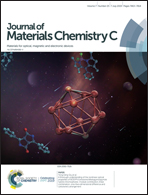The n- and p-type thermoelectric response of a semiconducting Co-based quaternary Heusler alloy: a density functional approach†
Abstract
In the combined framework of density functional and Boltzmann transport theory, we have systematically studied the electronic structure, mechanical stability and thermoelectric properties of the semiconducting quaternary Heusler alloy, CoFeTiAl. Ab initio simulation predicts a most stable non-magnetic semiconducting phase with a direct band gap of 1.39 eV at the Fermi level using the hybrid (HSE06) exchange–correlation functional. The formation energy (with respect to the elemental ground state) and lattice dynamics simulation suggests that the alloy is thermodynamically as well as mechanically stable. A detailed thermoelectric response (e.g., Seebeck coefficient, electrical and thermal conductivity and power factor) of the alloy has been investigated using Boltzmann transport theory for both electrons and phonons, as implemented in BoltzTraP and ShengBTE codes respectively. From the theoretical findings, we have obtained the upper limit of figure of merit and approaches to unity for both n- and p-type behavior at moderate temperatures. Hence a better thermoelectric response is expected from the present alloy for practical applications.



 Please wait while we load your content...
Please wait while we load your content...